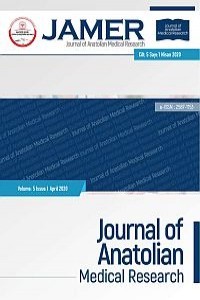Muzaffer KEKLİK, Uğur KALAN, Serdal KORKMAZ, Özerhan ÖZER, Pınar İPEK, Adile ORTAKÖYLÜOĞLU, Ertuğrul KEKLİK
Vitamin B12 deficiency among Newly-Arrived Syrian Refugees in Central Anatolia of Turkey
Purpose: Vitamin B12 (cobalamin) has the most complex chemical structure of all vitamins and it is obtained naturally only from products of animal origin in developing countries. Vitamin B12deficiency is prevalent in countries of origin of refugees. The aim of this study was to determine the prevalence of vitamin B12 deficiency among newly-arrived Syrian refugees in Central Anatolia of Turkey. Journal of Anatolian Medical Research 2017; 2(1): 22-30Orjinal Araştırma23Methods: Newly arrived 256 refugees aged ≥ 16 years were tested for vitamin B12 level and other hematological parameters. Results: We found that 50 participants (19.5%) had vitamin B12 deficiency (≤ 150 pmol/L). Low levels of vitamin B12 were prevalent among males those over the age of 50 (44.4%) (p=0.01) and females those under the age of 50 (75%) (p<0.001). Conclusion: The results of this study shown that, the prevalence of vitamin B12 deficiency was higher in Syrian refugees, especially in older men and younger women. To our knowledge, this is the first nationally representative study for Central Anatolia of Turkey about vitamin B12 deficiency in refugees.
Anahtar Kelimeler:
refugee, vit B12 deficiency
___
- 1. Dali-Youcef, N. and E. Andres, An update on cobalamin deficiency in adults. Qjm. 2009;102: 17-28. 2. McLean, E.D., L.H. Allen, C.G. Neumann, J.M. Peerson, J.H. Siekmann, S.P. Murphy, N.O. Bwibo, and M.W. Demment, Low plasma vitamin B-12 in Kenyan school children is highly prevalent and improved by supplemental animal source foods. J Nutr. 2007; 137:676-682. 3. Stabler, S.P. and R.H. Allen, Vitamin B12 deficiency as a worldwide problem. Annu Rev Nutr. 2004; 24: 299-326. 4. McLean, E., B. de Benoist, and L.H. Allen, Review of the magnitude of folate and vitamin B12 deficiencies worldwide. Food Nutr Bull. 2008; 29: 38-51. 5. Laillou, A., T.V. Pham, N.T. Tran, H.T. Le, F. Wieringa, F. Rohner, S. Fortin, M.B. Le, T. Tran do, R. Moench-Pfanner, and J. Berger, Micronutrient deficits are still public health issues among women and young children in Vietnam. PLoS One. 2012; 7: 34906. 6. Garcia-Casal, M.N., C. Osorio, M. Landaeta, I. Leets, P. Matus, F. Fazzino, and E. Marcos, High prevalence of folic acid and vitamin B12 deficiencies in infants, children, adolescents and pregnant women in Venezuela. Eur J Clin Nutr. 2005; 59:1064-1070. 7. Vitamin B12 deficiency in resettled Bhutanese refugees--United States, 2008-2011. MMWR Morb Mortal Wkly Rep. 2011; 60:343-346. 8. Benson, J., C. Phillips, M. Kay, M.T. Webber, A.J. Ratcliff, I. Correa-Velez, and M.F. Lorimer, Low vitamin B12 levels among newly-arrived refugees from Bhutan, Iran and Afghanistan: a multicentre Australian study. PLoS One. 2013; 8: 57998. 9. Paxton, G.A., K.J. Sangster, E.L. Maxwell, C.R. McBride, and R.H. Drewe, Post-arrival health screening in Karen refugees in Australia. PLoS One. 2012; 7: 38194. 10. de Benoist, B., Conclusions of a WHO Technical Consultation on folate and vitamin B12 deficiencies. Food Nutr Bull. 2008; 29:238-244. 11. Allen, L.H., How common is vitamin B-12 deficiency? Am J Clin Nutr. 2009; 89: 693-696. 12. Benson, J., T. Maldari, and T. Turnbull, Vitamin B12 deficiency - why refugee patients are at high risk. Aust Fam Physician. 2010; 39:215-217. 13. Thamm, M., G.B. Mensink, and W. Thierfelder, Folic acid intake of women in childbearing age. Gesundheitswesen. 1999; 61:207-212. 14. Green, T.J., B.J. Venn, C.M. Skeaff, and S.M. Williams, Serum vitamin B12 concentrations and atrophic gastritis in older New Zealanders. Eur J Clin Nutr. 2005; 59:205-210. 15. Allen, L.H., Causes of vitamin B12 and folate deficiency. Food Nutr Bull. 2008; 29:20-37. Journal of Anatolian Medical Research 2017; 2(1): 22-30 Orjinal Araştırma 30 16. Kaptan, K., C. Beyan, A.U. Ural, T. Cetin, F. Avcu, M. Gulsen, R. Finci, and A. Yalcin, Helicobacter pylori--is it a novel causative agent in Vitamin B12 deficiency? Arch Intern Med. 2000; 160:1349-1353. 17. Clarke, R., J. Grimley Evans, J. Schneede, E. Nexo, C. Bates, A. Fletcher, A. Prentice, C. Johnston, P.M. Ueland, H. Refsum, P. Sherliker, J. Birks, G. Whitlock, E. Breeze, and J.M. Scott, Vitamin B12 and folate deficiency in later life. Age Ageing. 2004; 33:34-41. 18. Carmel, R., I. Aurangzeb, and D. Qian, Associations of food-cobalamin malabsorption with ethnic origin, age, Helicobacter pylori infection, and serum markers of gastritis. Am J Gastroenterol. 2001; 96:63-70. 19. Green, R., Is it time for vitamin B-12 fortification? What are the questions? Am J Clin Nutr. 2009; 89:712-716. 20. Rosenberg, I.H., Science-based micronutrient fortification: which nutrients, how much, and how to know? Am J Clin Nutr.2005; 82:279-280. 21. Dary, O., Establishing safe and potentially efficacious fortification contents for folic acid and vitamin B12. Food Nutr Bull. 2008; 29:214-224. 22. McLean, E., M. Cogswell, I. Egli, D. Wojdyla, and B. de Benoist, Worldwide prevalence of anaemia, WHO Vitamin and Mineral Nutrition Information System, 1993-2005. Public Health Nutr. 2009; 12:444-454. 23. Pottie, K., C. Greenaway, J. Feightner, V. Welch, H. Swinkels, M. Rashid, L. Narasiah, L.J. Kirmayer, E. Ueffing, N.E. MacDonald, G. Hassan, M. McNally, K. Khan, R. Buhrmann, S. Dunn, A. Dominic, A.E. McCarthy, A.J. Gagnon, C. Rousseau, and P. Tugwell, Evidence-based clinical guidelines for immigrants and refugees. Cmaj. 2011; 183:824-925.
- Yayın Aralığı: Yılda 3 Sayı
- Başlangıç: 2016
- Yayıncı: Kayseri EAH
Sayıdaki Diğer Makaleler
ASPERGER BOZUKLUĞUNDA OKUL REDDİ: OLGU SERİSİ VE LİTERATÜRÜN GÖZDEN GEÇİRİLMESİ
Zehra Babadağı, Miraç Barış Usta, Koray Mehmet Zeynel Karabekiroglu
Vitamin B12 deficiency among Newly-Arrived Syrian Refugees in Central Anatolia of Turkey
Muzaffer KEKLİK, Uğur KALAN, Serdal KORKMAZ, Özerhan ÖZER, Pınar İPEK, Adile ORTAKÖYLÜOĞLU, Ertuğrul KEKLİK
BILATERAL SACROILIAC MILKMAN FRACTURE AND SACROİLİİTİS: CASE REPORT
Hava TALAY ÇALIŞ, Sema DEMİRCAN YAĞCI, Emel GÜLER, Ali KOÇ
Aynur Yurtseven, Mehmet Tatlı, Ismail Altintop
